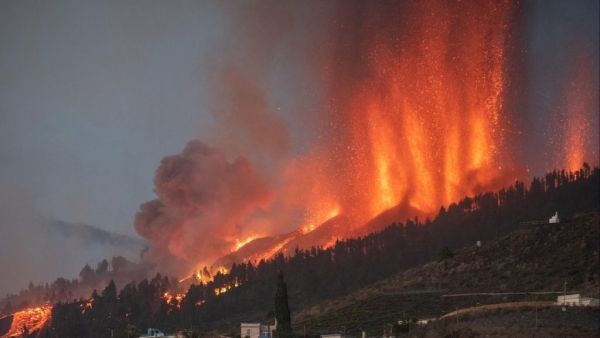La Palma volcano spews lava hundreds of feet in the air, but don't expect a 'mega-tsunami'

A volcano on the Spanish Canary Island of La Palma sent lava fountains shooting hundreds of feet into the air on Sunday (Sept. 19), forcing thousands of people to evacuate the area.
The volcano, called La Cumbre Vieja or "The Old Summit," last erupted in October 1971, when lava continually poured from the volcano for more than three weeks, according to NPR. This time around, the volcano is expected to remain active only "for the next few days," the president of the Canary Islands Ángel Víctor Torres said, Reuters reported.
Several streams of lava are still spilling from five fissures in the side of the volcano. One lava stream, measuring dozens of feet wide, reportedly surged over a number of homes in the nearby town of El Paso, from which residents had been directed to evacuate. In all, the eruption has destroyed about 100 homes in villages near Cumbre Vieja, BBC News reported. No casualties have been reported.
Related: Big blasts: History's 10 most destructive volcanoes
Video made by our colleague María Asensio who is at one of the lava flows of the eruption ... goosebumps #LaPalmaeruption pic.twitter.com/XlFIOMQ1biSeptember 19, 2021
"It is not foreseeable that anyone else will have to be evacuated. The lava is moving towards the coast" and is expected to reach the water by 8 p.m. local time, Torres said at a press conference on Sunday night, according to Reuters. At that time, experts estimated that about 600 million to 706 million cubic feet (17 million to 20 million cubic meters) of lava had flowed from the volcano, he said.
Authorities warned last week that La Cumbre Vieja might soon erupt, citing the fact that 4,000 tiny tremors had shaken the island since Sept. 11, El Pais reported on Sept. 16.
Known as a so-called earthquake swarm, these periods of persistent seismic activity can sometimes hint that a nearby volcano is getting ready to blow. In this case, the tremors steadily grew closer and closer to the Earth's surface, hinting that magma was migrating upward through the crust. In addition, authorities noted that the ground began to swell near the site of the quakes and had risen about 2.3 inches (6 centimeters) by Sept. 16.
Get the Space.com Newsletter
Breaking space news, the latest updates on rocket launches, skywatching events and more!
Based on this evidence, authorities then elevated the risk of a volcanic eruption to yellow, the second-highest in the three-tier system, El Pais reported. It was possible that the quakes could ultimately "amount to nothing," but Luca D'Auria, the head of the Volcano Monitoring Department at the Canary Islands Volcano Institute (Involcan), said he suspected that an eruption would likely occur in areas affected by the tremors.
Este impresionante time-lapse muestra cómo se veía el atardecer desde el Observatorio del Roque de los Muchachos @IAC_Astrofisica, en lo que ha sido la 1ra jornada de la erupción del #volcánLaPalmaLa cámara de @EELabs_eu seguirá emitiendo en directo enhttps://t.co/5w4D1RNJ80 pic.twitter.com/8PBpqPO52ESeptember 19, 2021
In the following days, the quakes grew even more persistent; a total of 22,000 tremors were ultimately recorded near the volcano in the week before the eruptions, BBC News reported. And on Sunday, D'Auria's prediction came true and lava burst through the ground at Cumbre Vieja. Thankfully, authorities had already begun evacuating people and farm animals from the area immediately surrounding the volcano, Reuters reported.
Involcan tweeted a video of dark smoke billowing from Cumbre Vieja at 3:36 p.m. local time on Sunday. Shortly after, the Volcanic Ash Advisory Center (VAAC) Toulouse reported that towering ash plumes, the tallest being about 3,280 feet (1,000 m) above sea level, could be seen rising from the volcano's gushing lava fountains.
As lava streams surged across La Palma, some news reports of the eruption raised concerns that the eruption could potentially send a "mega-tsunami" hurtling toward the Eastern U.S. — a fear that has been raised and debunked several times in the past, Newsweek reported.
The idea originally came from a 2001 study, published in the journal Geophysical Research Letters, which suggested that, if Cumbre Vieja ever erupted again, a huge chunk of the volcano could suddenly collapse into the Atlantic Ocean. The study authors estimated that, volume-wise, the chunk could measure between 35 and 120 cubic miles (150 to 500 cubic kilometers) and could send a wave as tall as 82 feet (25 m) crashing into the U.S. coast.
But based on recent surveys of Cumbre Vieja, experts have determined that such a monumental collapse would be extremely unlikely, Dave Petley, a landslide expert at the University of Sheffield, wrote in a blog for the American Geophysical Union. More recent studies suggest that, in the very worst-case scenario, about 19 cubic miles (80 cubic kilometers) of rock might slide off the volcano during a violent eruption, generating a wave that would be 6.5 feet (2 m) tall by the time it reached the Eastern Seaboard.
"But the current eruption at La Palma? It's very, very likely to remain a local hazard," volcanologist and science journalist Robin George Andrews posted on Twitter. "So don't buy into any fearmongering."
Originally published on Live Science.
Join our Space Forums to keep talking space on the latest missions, night sky and more! And if you have a news tip, correction or comment, let us know at: community@space.com.

Nicoletta Lanese is a staff writer for Live Science covering health and medicine, along with an assortment of biology, animal, environment and climate stories. She holds degrees in neuroscience and dance from the University of Florida and a graduate certificate in science communication from the University of California, Santa Cruz. Her work has appeared in The Scientist Magazine, Science News, The San Jose Mercury News and Mongabay, among other outlets.










